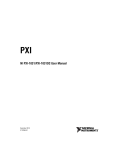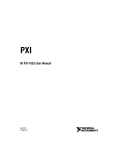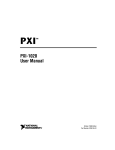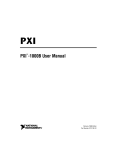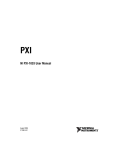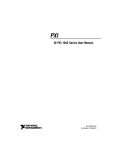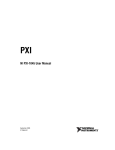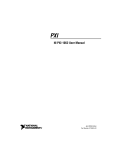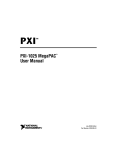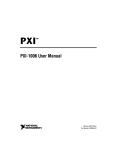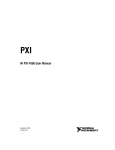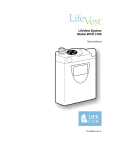Download NI PXI-1031/PXI-1031DC User Manual
Transcript
PXI NI PXI-1031/PXI-1031DC User Manual NI PXI-1031/PXI-1031DC User Manual October 2004 371226B-01 Support Worldwide Technical Support and Product Information ni.com National Instruments Corporate Headquarters 11500 North Mopac Expressway Austin, Texas 78759-3504 USA Tel: 512 683 0100 Worldwide Offices Australia 1800 300 800, Austria 43 0 662 45 79 90 0, Belgium 32 0 2 757 00 20, Brazil 55 11 3262 3599, Canada (Calgary) 403 274 9391, Canada (Ottawa) 613 233 5949, Canada (Québec) 450 510 3055, Canada (Toronto) 905 785 0085, Canada (Vancouver) 604 685 7530, China 86 21 6555 7838, Czech Republic 420 224 235 774, Denmark 45 45 76 26 00, Finland 385 0 9 725 725 11, France 33 0 1 48 14 24 24, Germany 49 0 89 741 31 30, India 91 80 51190000, Israel 972 0 3 6393737, Italy 39 02 413091, Japan 81 3 5472 2970, Korea 82 02 3451 3400, Malaysia 603 9131 0918, Mexico 01 800 010 0793, Netherlands 31 0 348 433 466, New Zealand 0800 553 322, Norway 47 0 66 90 76 60, Poland 48 22 3390150, Portugal 351 210 311 210, Russia 7 095 783 68 51, Singapore 65 6226 5886, Slovenia 386 3 425 4200, South Africa 27 0 11 805 8197, Spain 34 91 640 0085, Sweden 46 0 8 587 895 00, Switzerland 41 56 200 51 51, Taiwan 886 2 2528 7227, Thailand 662 992 7519, United Kingdom 44 0 1635 523545 For further support information, refer to the Technical Support and Professional Services appendix. To comment on National Instruments documentation, refer to the National Instruments Web site at ni.com/info and enter the info code feedback. © 2004 National Instruments Corporation. All rights reserved. Important Information Warranty The NI PXI-1031 and NI PXI-1031DC are warranted against defects in materials and workmanship for a period of one year from the date of shipment, as evidenced by receipts or other documentation. National Instruments will, at its option, repair or replace equipment that proves to be defective during the warranty period. This warranty includes parts and labor. The media on which you receive National Instruments software are warranted not to fail to execute programming instructions, due to defects in materials and workmanship, for a period of 90 days from date of shipment, as evidenced by receipts or other documentation. National Instruments will, at its option, repair or replace software media that do not execute programming instructions if National Instruments receives notice of such defects during the warranty period. National Instruments does not warrant that the operation of the software shall be uninterrupted or error free. A Return Material Authorization (RMA) number must be obtained from the factory and clearly marked on the outside of the package before any equipment will be accepted for warranty work. National Instruments will pay the shipping costs of returning to the owner parts which are covered by warranty. National Instruments believes that the information in this document is accurate. The document has been carefully reviewed for technical accuracy. In the event that technical or typographical errors exist, National Instruments reserves the right to make changes to subsequent editions of this document without prior notice to holders of this edition. The reader should consult National Instruments if errors are suspected. In no event shall National Instruments be liable for any damages arising out of or related to this document or the information contained in it. EXCEPT AS SPECIFIED HEREIN, NATIONAL INSTRUMENTS MAKES NO WARRANTIES, EXPRESS OR IMPLIED, AND SPECIFICALLY DISCLAIMS ANY WARRANTY OF MERCHANTABILITY OR FITNESS FOR A PARTICULAR PURPOSE. CUSTOMER’S RIGHT TO RECOVER DAMAGES CAUSED BY FAULT OR NEGLIGENCE ON THE PART OF NATIONAL INSTRUMENTS SHALL BE LIMITED TO THE AMOUNT THERETOFORE PAID BY THE CUSTOMER. NATIONAL INSTRUMENTS WILL NOT BE LIABLE FOR DAMAGES RESULTING FROM LOSS OF DATA, PROFITS, USE OF PRODUCTS, OR INCIDENTAL OR CONSEQUENTIAL DAMAGES, EVEN IF ADVISED OF THE POSSIBILITY THEREOF. This limitation of the liability of National Instruments will apply regardless of the form of action, whether in contract or tort, including negligence. Any action against National Instruments must be brought within one year after the cause of action accrues. National Instruments shall not be liable for any delay in performance due to causes beyond its reasonable control. The warranty provided herein does not cover damages, defects, malfunctions, or service failures caused by owner’s failure to follow the National Instruments installation, operation, or maintenance instructions; owner’s modification of the product; owner’s abuse, misuse, or negligent acts; and power failure or surges, fire, flood, accident, actions of third parties, or other events outside reasonable control. Copyright Under the copyright laws, this publication may not be reproduced or transmitted in any form, electronic or mechanical, including photocopying, recording, storing in an information retrieval system, or translating, in whole or in part, without the prior written consent of National Instruments Corporation. Trademarks National Instruments™, National Instruments Alliance Partner™, NI™, ni.com™, NI-DAQ™, and NI-VISA™ are trademarks of National Instruments Corporation. Product and company names mentioned herein are trademarks or trade names of their respective companies. Members of the National Instruments Alliance Partner Program are business entities independent from National Instruments and have no agency, partnership, or joint-venture relationship with National Instruments. Patents For patents covering National Instruments products, refer to the appropriate location: Help»Patents in your software, the patents.txt file on your CD, or ni.com/patents. WARNING REGARDING USE OF NATIONAL INSTRUMENTS PRODUCTS (1) NATIONAL INSTRUMENTS PRODUCTS ARE NOT DESIGNED WITH COMPONENTS AND TESTING FOR A LEVEL OF RELIABILITY SUITABLE FOR USE IN OR IN CONNECTION WITH SURGICAL IMPLANTS OR AS CRITICAL COMPONENTS IN ANY LIFE SUPPORT SYSTEMS WHOSE FAILURE TO PERFORM CAN REASONABLY BE EXPECTED TO CAUSE SIGNIFICANT INJURY TO A HUMAN. (2) IN ANY APPLICATION, INCLUDING THE ABOVE, RELIABILITY OF OPERATION OF THE SOFTWARE PRODUCTS CAN BE IMPAIRED BY ADVERSE FACTORS, INCLUDING BUT NOT LIMITED TO FLUCTUATIONS IN ELECTRICAL POWER SUPPLY, COMPUTER HARDWARE MALFUNCTIONS, COMPUTER OPERATING SYSTEM SOFTWARE FITNESS, FITNESS OF COMPILERS AND DEVELOPMENT SOFTWARE USED TO DEVELOP AN APPLICATION, INSTALLATION ERRORS, SOFTWARE AND HARDWARE COMPATIBILITY PROBLEMS, MALFUNCTIONS OR FAILURES OF ELECTRONIC MONITORING OR CONTROL DEVICES, TRANSIENT FAILURES OF ELECTRONIC SYSTEMS (HARDWARE AND/OR SOFTWARE), UNANTICIPATED USES OR MISUSES, OR ERRORS ON THE PART OF THE USER OR APPLICATIONS DESIGNER (ADVERSE FACTORS SUCH AS THESE ARE HEREAFTER COLLECTIVELY TERMED “SYSTEM FAILURES”). ANY APPLICATION WHERE A SYSTEM FAILURE WOULD CREATE A RISK OF HARM TO PROPERTY OR PERSONS (INCLUDING THE RISK OF BODILY INJURY AND DEATH) SHOULD NOT BE RELIANT SOLELY UPON ONE FORM OF ELECTRONIC SYSTEM DUE TO THE RISK OF SYSTEM FAILURE. TO AVOID DAMAGE, INJURY, OR DEATH, THE USER OR APPLICATION DESIGNER MUST TAKE REASONABLY PRUDENT STEPS TO PROTECT AGAINST SYSTEM FAILURES, INCLUDING BUT NOT LIMITED TO BACK-UP OR SHUT DOWN MECHANISMS. BECAUSE EACH END-USER SYSTEM IS CUSTOMIZED AND DIFFERS FROM NATIONAL INSTRUMENTS' TESTING PLATFORMS AND BECAUSE A USER OR APPLICATION DESIGNER MAY USE NATIONAL INSTRUMENTS PRODUCTS IN COMBINATION WITH OTHER PRODUCTS IN A MANNER NOT EVALUATED OR CONTEMPLATED BY NATIONAL INSTRUMENTS, THE USER OR APPLICATION DESIGNER IS ULTIMATELY RESPONSIBLE FOR VERIFYING AND VALIDATING THE SUITABILITY OF NATIONAL INSTRUMENTS PRODUCTS WHENEVER NATIONAL INSTRUMENTS PRODUCTS ARE INCORPORATED IN A SYSTEM OR APPLICATION, INCLUDING, WITHOUT LIMITATION, THE APPROPRIATE DESIGN, PROCESS AND SAFETY LEVEL OF SUCH SYSTEM OR APPLICATION. Contents About This Manual Conventions ...................................................................................................................vii Related Documentation..................................................................................................viii Chapter 1 Getting Started Unpacking ......................................................................................................................1-1 What You Need to Get Started ......................................................................................1-1 Key Features ..................................................................................................................1-2 Chassis Description........................................................................................................1-3 Optional Equipment .......................................................................................................1-5 EMC Filler Panels ...........................................................................................1-5 Rack Mount Kits..............................................................................................1-5 Handle/Feet Kit ...............................................................................................1-5 DC Power Cable (PXI-1031DC Only) ............................................................1-6 PXI-1031/PXI-1031DC Backplane Overview...............................................................1-6 Interoperability with CompactPCI ..................................................................1-6 System Controller Slot ....................................................................................1-6 Star Trigger Slot ..............................................................................................1-7 Peripheral Slots................................................................................................1-7 Local Bus.........................................................................................................1-7 Trigger Bus......................................................................................................1-8 System Reference Clock..................................................................................1-8 Chapter 2 Installation and Configuration Safety Information .........................................................................................................2-1 Chassis Cooling Considerations ....................................................................................2-2 Providing Adequate Clearance ........................................................................2-2 Setting Fan Speed ............................................................................................2-3 Installing Filler Panels.....................................................................................2-3 Rack Mounting ..............................................................................................................2-4 Connecting Safety Ground.............................................................................................2-4 Connecting to Power Source..........................................................................................2-4 Connecting to an AC Power Source................................................................2-5 Connecting to a DC Power Source (PXI-1031DC Only)................................2-5 DC Connector ...................................................................................2-5 © National Instruments Corporation v NI PXI-1031/PXI-1031DC User Manual Contents Installing a PXI Controller ............................................................................................ 2-6 Installing PXI Modules.................................................................................................. 2-8 PXI System Configuration with MAX .......................................................................... 2-9 Basic PXI System Configuration .................................................................... 2-10 Trigger Configuration in MAX....................................................................... 2-11 Using System Configuration and Initialization Files .................................................... 2-11 Chapter 3 Maintenance DC Fuse Replacement (PXI-1031DC Only) ................................................................. 3-1 Service Interval.............................................................................................................. 3-1 Preparation..................................................................................................................... 3-1 Cleaning......................................................................................................................... 3-2 Interior Cleaning ............................................................................................. 3-2 Exterior Cleaning ............................................................................................ 3-2 Cleaning and Replacing the Fan Filter .......................................................................... 3-2 Appendix A Specifications Appendix B Pinouts Appendix C Technical Support and Professional Services Glossary Index NI PXI-1031/PXI-1031DC User Manual vi ni.com About This Manual The NI PXI-1031/PXI-1031DC User Manual contains information about installing, configuring, using, and maintaining the NI PXI-1031 and PXI-1031DC chassis. Conventions The following conventions are used in this manual: » The » symbol leads you through nested menu items and dialog box options to a final action. The sequence File»Page Setup»Options directs you to pull down the File menu, select the Page Setup item, and select Options from the last dialog box. This icon denotes a note, which alerts you to important information. This icon denotes a caution, which advises you of precautions to take to avoid injury, data loss, or a system crash. When this symbol is marked on the product, refer to the Read Me First: Safety and Radio-Frequency Interference document, shipped with the product, for precautions to take. bold Bold text denotes items that you must select or click in the software, such as menu items and dialog box options. Bold text also denotes parameter names. italic Italic text denotes variables, emphasis, a cross reference, a hardware label, or an introduction to a key concept. This font also denotes text that is a placeholder for a word or value that you must supply. monospace Text in this font denotes text or characters that you should enter from the keyboard, sections of code, programming examples, and syntax examples. This font is also used for the proper names of disk drives, paths, directories, programs, subprograms, subroutines, device names, functions, operations, variables, filenames, and extensions. © National Instruments Corporation vii NI PXI-1031/PXI-1031DC User Manual About This Manual Related Documentation The following documents contain information that you might find helpful as you read this manual: • NI PXI-1031DC DC Cable Kit Installation Guide • CompactPCI Specification PICMG 2.0 R 3.0 • PXI Hardware Specification • PXI Software Specification • IEEE 1101.1-1991, IEEE Standard for Mechanical Core Specifications for Microcomputers Using IEC 603-2 Connectors • IEEE 1101.10, IEEE Standard for Additional Mechanical Specifications for Microcomputers Using IEEE 1101.1 Equipment Practice NI PXI-1031/PXI-1031DC User Manual viii ni.com 1 Getting Started This chapter describes the key features of the NI PXI-1031 and PXI-1031DC chassis, and lists the kit contents and optional equipment you can order from National Instruments. Unpacking Carefully inspect the shipping container and the chassis for damage. Check for visible damage to the metal work. Check to make sure all handles, hardware, and switches are undamaged. Inspect the inner chassis for any possible damage, debris, or detached components. If damage appears to have been caused during shipment, file a claim with the carrier. Retain the packing material for possible inspection and/or reshipment. What You Need to Get Started ❑ NI PXI-1031 or NI PXI-1031DC chassis ❑ Filler panels ❑ Power cable, either: – AC power cable—refer to Table 1-1 for AC power cables – DC power cable ❑ NI PXI-1031/PXI-1031DC User Manual ❑ Read Me First: Safety and Radio-Frequency Interference ❑ Driver CD-ROM containing NI PXI chassis software ❑ Chassis number labels © National Instruments Corporation 1-1 NI PXI-1031/PXI-1031DC User Manual Chapter 1 Getting Started Table 1-1. AC Power Cables Power Cable Reference Standards Standard 120 V (USA) NEMA 5-15 Switzerland 220 V SEV Australia 240 V AS C112 Universal Euro 230 V CEE (7), II, IV, VII IEC83 North America 240 V NEMA 6-15 United Kingdom 230 V BS 1363/IEC83 If you are missing any of the items listed in Table 1-1, or if you have the incorrect AC power cable, contact National Instruments. You have the option of powering the PXI-1031DC chassis with a DC power cable through the DC input connector on the rear panel of the chassis. Refer to Figure 1-3 for the location of the DC connector. Key Features The PXI-1031/PXI-1031DC combines a 4-slot PXI backplane with a structural design that has been optimized for maximum usability in a wide range of applications. The key features of the chassis include the following: • Accepts 3U PXI and CompactPCI (PICMG 2.0 R 3.0) modules • 4-slot chassis with universal AC input, and automatic voltage/frequency ranging • DC power input (PXI-1031DC only) • On/Off (Standby) power switch on the front panel for easy access • AUTO/HIGH temperature-controlled fan speed based on air-intake temperature to minimize audible noise • (Optional) Carrying handle for portability • Rack mountable NI PXI-1031/PXI-1031DC User Manual 1-2 ni.com Chapter 1 Getting Started Chassis Description Figure 1-1, Figure 1-2, and Figure 1-3 show the key features of the PXI-1031/PXI-1031DC chassis front and rear panels. Figure 1-1 shows the front view of the PXI-1031 (the PXI-1031DC front panel is identical except for the chassis name stenciled on the face plate). Figure 1-2 shows the rear view of the PXI-1031. Figure 1-3 shows the rear panel of the PXI-1031DC. Figure 1-4 shows the bottom of the chassis (both types of chassis will be identical on the bottom). 1 2 3 10 4 5 9 1 2 3 4 5 Controller Expansion Slots Captive Screw PXI Filler Panel PXI Backplane Rubber Foot 8 6 7 8 9 10 7 6 PXI Expansion Slots Star Trigger Peripheral Slot Embedded Controller Slot Power Switch (Standby) Power Supply Airflow Intake Vents Figure 1-1. Front View of the PXI-1031 Chassis © National Instruments Corporation 1-3 NI PXI-1031/PXI-1031DC User Manual Chapter 1 Getting Started 1 2 3 6 1 2 3 5 4 Rear Exhaust Vents AC Input Power Supply Fan Exhaust 4 5 6 Chassis Ground Screw Fan Speed Selector Switch Rubber Foot Figure 1-2. Rear View of the PXI-1031 Chassis 2 1 CAUTION: BOTH POWER SOURCES MUST BE DISCONNECTED TO REMOVE ALL POWER FROM UNIT 100-240 VAC 50/60 Hz, 4-2 A F30A/32V 11-30V 30-10A MAX 3 4 5 8 1 2 3 4 7 Rear Exhaust Vents DC Fuse Socket DC Input AC Input 6 5 6 7 8 Power Supply Fan Exhaust Chassis Ground Screw AUTO/HIGH Fan Speed Selector Switch Rubber Foot Figure 1-3. Rear View of the PXI-1031DC Chassis NI PXI-1031/PXI-1031DC User Manual 1-4 ni.com Chapter 1 1 Getting Started 2 4 3 1 2 Power Switch (Standby) Air Flow Filter Cover 3 4 Rubber Foot Air Flow Filter Cover Screw Figure 1-4. Bottom View of PXI-1031/PXI-1031DC Chassis Optional Equipment Contact National Instruments to order the following options for the PXI-1031/PXI-1031DC chassis. EMC Filler Panels Optional EMC filler panel kits are available from National Instruments. Rack Mount Kits A rack mount kit option is available for mounting the PXI-1031 or PXI-1031DC chassis into a 19 in. instrument cabinet. Handle/Feet Kit An optional side handle and rubber feet kit is available from National Instruments to provide a handle for portability. © National Instruments Corporation 1-5 NI PXI-1031/PXI-1031DC User Manual Chapter 1 Getting Started DC Power Cable (PXI-1031DC Only) An optional DC power cable is available from National Instruments to provide power through the DC input connector on the rear panel of the chassis. PXI-1031/PXI-1031DC Backplane Overview Interoperability with CompactPCI The PXI-1031/PXI-1031DC backplane is interoperable with 5 V and universal PXI-compatible products and standard CompactPCI products. This is an important feature, because some PXI systems may require components that do not implement PXI-specific features. For example, you may want to use a standard CompactPCI network interface card in a PXI chassis. The signals on the backplane P1 connectors meet the requirements of the CompactPCI specification for both peripheral and system modules. Refer to Appendix B, Pinouts, for pinout information. The PXI-specific signals are on the backplane P2 connectors and are found only on those signal lines reserved or not used in the CompactPCI 64-bit specification. Therefore, all modules that meet the requirements of the CompactPCI 64-bit specification will function in the PXI-1031/PXI-1031DC. Refer to Appendix B, Pinouts, for pinout information. The chassis backplane has +5 V V(I/O). Refer to the CompactPCI Specification PICMG 2.0 R 3.0 for details regarding V(I/O). System Controller Slot The system controller slot is slot 1 of the chassis as defined by the PXI specification. It has three controller expansion slots for system controller modules that are wider than one slot. As defined in the PXI specification, these slots allow the controller to expand to the left to prevent the controller from using peripheral slots. NI PXI-1031/PXI-1031DC User Manual 1-6 ni.com Chapter 1 Getting Started Star Trigger Slot The star trigger (ST) slot is slot 2. This slot has dedicated equal-length trigger lines between slot 2 and peripheral slots 3 and 4 (refer to Figure 1-5). Slot 2 is intended for modules with ST functionality that can provide individual triggers to all other peripheral modules. However, if you do not require advanced trigger functionality, you can install any standard peripheral module in this slot. The star trigger slot can also be used to provide a PXI_CLK10 signal to the backplane. For more information regarding PXI_CLK10, refer to the System Reference Clock section. Peripheral Slots There are three peripheral slots, including the star trigger slot. Local Bus The PXI backplane local bus is a daisy-chained bus that connects each peripheral slot with adjacent peripheral slots to the left and right (refer to Figure 1-5). For example, the right local bus of slot 2 connects to the left local bus of slot 3, and so on. The left local bus signal lines on slot 2 are used for star trigger and do not connect to slot 1. The right local bus signal lines on slot 4 are not routed anywhere. Each local bus is 13 lines wide and can pass analog signals up to 42 V between cards or provide a high-speed TTL side-band digital communication path that does not reduce the PXI bus bandwidth. Initialization software uses the configuration information specific to adjacent peripheral modules to evaluate local bus compatibility. © National Instruments Corporation 1-7 NI PXI-1031/PXI-1031DC User Manual Chapter 1 Getting Started Local Bus Peripheral Slot [4] Local Bus Peripheral Slot [3] System Controller Slot [1] Star Trigger/Peripheral Slot [2] Star Triggers PCI Arbitration and Clock Signals Figure 1-5. PXI Star Trigger and Local Bus Routing Trigger Bus All slots share eight PXI trigger lines. You can use these trigger lines in a variety of ways. For example, you can use triggers to synchronize the operation of several different PXI peripheral modules. In other applications, one module located in slot 2 can control carefully timed sequences of operations performed on other modules in the system. Modules can pass triggers to one another, allowing precisely timed responses to asynchronous external events the system is monitoring or controlling. System Reference Clock The PXI-1031/PXI-1031DC supplies the PXI 10 MHz system clock signal (PXI_CLK10) independently to each peripheral slot. An independent buffer (having a source impedance matched to the backplane and a skew of less than 1 ns between slots) drives the clock signal to each peripheral slot. You can use this common reference clock signal to synchronize multiple modules in a measurement or control system. You can drive PXI_CLK10 from an external source through the PXI_CLK10_IN pin on the P2 connector of the star trigger slot. Refer to Table B-4, P2 (J2) Connector Pinout for the Star Trigger Slot. You must manually switch SW1 on the chassis backplane to enable or disable routing an external clock to peripheral slots. NI PXI-1031/PXI-1031DC User Manual 1-8 ni.com Installation and Configuration 2 This chapter describes how to install, configure, and use the PXI-1031 and PXI-1031DC chassis. Before connecting the chassis to a power source, read this chapter and the Read Me First: Safety and Radio-Frequency Interference document included with your chassis. Safety Information Before undertaking any troubleshooting, maintenance, or exploratory procedure, carefully read the following caution notices. Caution This equipment contains voltage hazardous to human life and safety, and is capable of inflicting personal injury. • Chassis Grounding—The chassis requires a connection from the premise wire safety ground to the chassis ground. The earth safety ground must be connected during use of this equipment to minimize shock hazards. Refer to the Connecting Safety Ground section for instructions on connecting safety ground. • Live Circuits—Operating personnel and service personnel must not remove protective covers when operating or servicing the chassis. Adjustments and service to internal components must be undertaken by qualified service technicians. During service of this product, the mains connector to the premise wiring must be disconnected. Dangerous voltages may be present under certain conditions; use extreme caution. • Explosive Atmosphere—Do not operate the chassis in conditions where flammable gases are present. Under such conditions, this equipment is unsafe and may ignite the gases or gas fumes. © National Instruments Corporation 2-1 NI PXI-1031/PXI-1031DC User Manual Chapter 2 Installation and Configuration • Part Replacement—Only service this equipment with parts that are exact replacements, both electrically and mechanically. Contact National Instruments for replacement part information. Installation of parts with those that are not direct replacements may cause harm to personnel operating the chassis. Furthermore, damage or fire may occur if replacement parts are unsuitable. • Modification—Do not modify any part of the chassis from its original condition. Unsuitable modifications may result in safety hazards. Chassis Cooling Considerations The chassis is designed to operate on a bench or in an instrument rack. Determine how you want to use the chassis and follow the appropriate installation instructions. Providing Adequate Clearance Apertures in the top, bottom, front, rear, and along the right side of the chassis facilitate power supply and module cooling. Air enters through filters and fan inlet in the bottom of the chassis for module cooling. It then exits through the upper sections at the right side, back, and through the top, as shown in Figure 2-1. Air cooling the power supply enters the front of the chassis, which is shown in Figure 1-1, Front View of the PXI-1031 Chassis, then exits through the rear of the chassis, which is shown in Figure 1-2, Rear View of the PXI-1031 Chassis, and Figure 1-3, Rear View of the PXI-1031DC Chassis. Place the chassis on a bench top or in an instrument rack so that the fans (air inlets) and the air outlet apertures along the right side, the top, and the back of the chassis have adequate ventilation. Provide at least 44.5 mm (1.75 in.) clearance above, behind, and on the sides of the unit for adequate venting. High-power applications may require additional clearance. NI PXI-1031/PXI-1031DC User Manual 2-2 ni.com Chapter 2 Installation and Configuration 1 2 1 Air Outlets 2 Air Intake Figure 2-1. PXI-1031/PXI-1031DC Module Cooling Airflow Side View Install the chassis so that you can easily access the bottom panel. This simplifies replacing the air filters, if necessary. Setting Fan Speed The AUTO/HIGH fan-speed selector switch is on the rear panel of the PXI-1031 and PXI-1031DC. Refer to Figure 1-2, Rear View of the PXI-1031 Chassis, or Figure 1-3, Rear View of the PXI-1031DC Chassis, to locate the fan-speed selector switch. Select HIGH for maximum cooling performance (recommended) or AUTO for quieter operation. The fan speed is determined by chassis intake air temperature when set to AUTO. Installing Filler Panels To improve module cooling performance, install filler panels (provided with the chassis) in unused or empty slots. Secure with the captive mounting screws provided. © National Instruments Corporation 2-3 NI PXI-1031/PXI-1031DC User Manual Chapter 2 Installation and Configuration Rack Mounting Rack mount applications require the optional rack mount kits available from National Instruments. Refer to Figure A-3, PXI-1031/PXI-1031DC Rack Mount Kit Components, and the instructions supplied with the rack mount kits to install your chassis in an instrument rack. You may want to remove the feet from the chassis when rack mounting. To do so, remove the screws holding the feet in place. Note Connecting Safety Ground Caution The PXI-1031/PXI-1031DC chassis is designed with a three-position inlet that connects the cord set ground line to the chassis ground. To minimize shock hazard, make sure the electrical power outlet you use to power the chassis has an appropriate earth safety ground. For DC powered applications, or if your power outlet does not have an appropriate ground connection, you must connect the premise safety ground to the chassis grounding screw located on the rear panel. Refer to Figure 1-2, Rear View of the PXI-1031 Chassis, or Figure 1-3, Rear View of the PXI-1031DC Chassis, to locate the chassis grounding screw. Complete the following steps to connect the safety ground. 1. Connect a 10 AWG (2.6 mm) wire to the chassis grounding screw using a grounding lug. The wire must have green insulation with a yellow stripe or must be noninsulated (bare). 2. Attach the opposite end of the wire to permanent earth ground using toothed washers or a toothed lug. Connecting to Power Source Cautions Do not install modules prior to performing the following power-on test. To completely remove power, you must disconnect the AC power cable (and DC power, if applicable). If both AC and DC power cables are connected, the chassis will draw power from both sources. NI PXI-1031/PXI-1031DCUser Manual 2-4 ni.com Chapter 2 Installation and Configuration Connecting to an AC Power Source Attach input power through the rear AC inlet using the appropriate AC power cable supplied. Refer to Figure 1-2, Rear View of the PXI-1031 Chassis, or to Figure 1-3, Rear View of the PXI-1031DC Chassis, to locate the AC inlet. The power switch allows you to power on the chassis or place it in standby mode. Press the power switch to the On position (if not already on). Observe that all fans become operational. Connecting to a DC Power Source (PXI-1031DC Only) Table 2-1. DC Power Requirements Electrical Element Requirement Voltage 11–30 VDC Max. DC Input Current 30 amps For full chassis power, the DC source must be capable of providing a minimum of 300 watts of continuous power per feed pair to the P1 connector on the PXI-1031DC power supply. DC Connector Figure 2-2 shows the DC connector (P1) that appears on the rear panel of the PXI-1031DC power supply. Positive (+) Negative (–) P1 Figure 2-2. The P1 DC Input Connector © National Instruments Corporation 2-5 NI PXI-1031/PXI-1031DC User Manual Chapter 2 Installation and Configuration To build a custom DC cable, be sure to note the positive (+) and negative (–) terminals shown in Figure 2-2. Use the following components or their equivalents to mate to the P1 port: • Positronic connector, part number CBD7W2F0000 • Positronic hood, part number D15000GE0 • Two Positronic contacts, part number FS4008D (choice of solder cup or crimp terminals) • Use of UL listed AWG #10 wire is recommended (maximum length: 216 in.) Install an F30A 500 VDC/600 VAC, 1.5 in. × .41 in. (10 mm × 38 mm) Midget fast-acting fuse on the positive (+) wire of the custom cable as close to the power source as practical. • A Ferraz-Shawmut FEB-81-81 fuse holder, with Ferraz-Shawmut FSB1 insulating boots, and an ATM30 fuse is recommended. Refer to the NI PXI-1031DC DC Cable Kit Installation Guide for information on fuse installation. You can purchase an optional DC cable from National Instruments that incorporates an in-line fuse and the mating connector for the P1 port. Note Installing a PXI Controller This section contains general instructions for installing a PXI controller in the chassis. Refer to your PXI controller user manual for specific instructions and cautions. Complete the following steps to install a controller. 1. Connect the AC or DC power source to the PXI chassis before installing the controller. The AC power cord grounds the chassis and protects it from electrical damage while you install the controller. For DC powered applications, make sure the chassis is properly grounded through the chassis ground screw. Make sure the chassis power switch is in the Off (Standby) position. To protect both yourself and the chassis from electrical hazards, leave the chassis off until you finish installing the controller. Caution NI PXI-1031/PXI-1031DC User Manual 2-6 ni.com Chapter 2 2. Installation and Configuration Install the controller into the system controller slot (slot 1, indicated by the red card guides) by first placing the controller edges into the front controller guides (top and bottom). Slide the controller to the rear of the chassis, making sure that the injector/ejector handle is pushed down as shown in Figure 2-3. Figure 2-3. Injector/Ejector Handle Position during Controller or Peripheral Module Insertion 3. When you begin to feel resistance, push up on the injector/ejector handle to inject the controller fully into the chassis frame. Secure the controller front panel to the chassis using the controller front-panel mounting screws. 4. Connect the keyboard, mouse, and monitor to the appropriate connectors. Connect devices to ports as required by your system configuration. 5. Power on the chassis. Verify that the controller boots. If the controller does not boot, refer to your controller user manual. © National Instruments Corporation 2-7 NI PXI-1031/PXI-1031DC User Manual Chapter 2 Installation and Configuration Figure 2-4 shows a PXI controller installed in the system controller slot of a PXI-1031/PXI-1031DC chassis. You can place CompactPCI or PXI modules in any other slot. 1 3 2 1 PXI-1031/PXI-1031DC Chassis 2 Injector/Ejector Rail 3 NI PXI Controller Figure 2-4. NI PXI Controller Installed in a PXI-1031/PXI-1031DC Chassis Installing PXI Modules Complete the following steps to install a module. 1. Make sure the power switch is in the Off (Standby) position. 2. Install a module into a chassis slot by first placing the module card edges into the front module guides (top and bottom), as shown in Figure 2-5. Slide the module to the rear of the chassis, making sure that the injector/ejector handle is pushed down as shown in Figure 2-3. 3. When you begin to feel resistance, push up on the injector/ejector handle to fully inject the module into the chassis frame. Secure the module front panel to the chassis using the module front-panel mounting screws. NI PXI-1031/PXI-1031DC User Manual 2-8 ni.com Chapter 2 Installation and Configuration 1 5 4 2 3 1 2 PXI-1031/PXI-1031DC Chassis Injector/Ejector Rail 3 4 Injector/Ejector Handle PXI Module 5 NI PXI Controller Figure 2-5. Installing PXI or CompactPCI Modules PXI System Configuration with MAX Configuration of the PXI system is handled through Measurement & Automation Explorer (MAX), included on the NI Driver CD-ROM packaged with your kit. MAX creates the pxisys.ini file that defines the layout and parameters of your PXI system. After installing the software on the NI Driver CD-ROM, the MAX icon will be present on the desktop. The configuration steps for single or multiple chassis systems are the same. © National Instruments Corporation 2-9 NI PXI-1031/PXI-1031DC User Manual Chapter 2 Installation and Configuration Figure 2-6. Chassis Configuration in MAX Basic PXI System Configuration Refer to Figure 2-6 while completing the following steps: 1. Launch MAX. 2. In the Configuration tree, click the Devices and Interfaces branch to expand it. 3. If the PXI system controller has not yet been configured, it will be labeled PXI System (Unidentified). Right-click this entry to display the context menu and then select the appropriate controller model from the Identify As submenu. 4. Click the PXI System controller, and the chassis (or multiple chassis, in a multi-chassis configuration) will be listed below it. Identify each chassis by right-clicking its entry and then selecting the appropriate chassis model through the Identify As submenu. Further expanding the PXI System branch will show all of the devices in the system that can be recognized by NI-VISA. After your controller and all of your chassis have been identified, the required pxisys.ini file will be complete. NI PXI-1031/PXI-1031DC User Manual 2-10 ni.com Chapter 2 5. Installation and Configuration Apply the chassis number labels (shown in Figure 2-7) included with your kit to each chassis in your PXI system, and write in the chassis number accordingly in the white space. Figure 2-7. Chassis Number Label Trigger Configuration in MAX Each chassis has one or more trigger buses, each with eight lines numbered 0 through 7 that can be reserved and routed statically or dynamically. Static reservation “pre-allocates” a trigger line to prevent its configuration by a user program. Dynamic reservation/routing/deallocation is performed on the fly within a user program based upon National Instruments APIs such as NI-DAQmx. Static reservation of trigger lines can be implemented by the user in MAX through the Triggers tab. Reserved trigger lines will not be used by PXI modules dynamically configured by programs such as NI-DAQmx. This prevents the instruments from double-driving the trigger lines, possibly damaging devices in the chassis. Complete the following steps to reserve these trigger lines in MAX. 1. In the Configuration tree, click the PXI chassis branch you want to configure. 2. Click the Triggers tab at the bottom of the right-hand pane. 3. Select which trigger lines you want to statically reserve. 4. Click the Apply button. Using System Configuration and Initialization Files The PXI specification allows many combinations of PXI chassis and system modules. To assist system integrators, the manufacturers of PXI chassis and system modules must document the capabilities of their products. The minimum documentation requirements are contained in .ini files, which consist of ASCII text. System integrators, configuration utilities, and device drivers can use these .ini files. The capability documentation for the PXI-1031/PXI-1031DC chassis is contained in the chassis.ini file on the software media that comes with the chassis. The information in this file is combined with information about © National Instruments Corporation 2-11 NI PXI-1031/PXI-1031DC User Manual Chapter 2 Installation and Configuration the system controller to create a single system initialization file called pxisys.ini (PXI System Initialization). The system controller manufacturer either provides a pxisys.ini file for the particular chassis model that contains the system controller or provides a utility that can read an arbitrary chassis.ini file and generate the corresponding pxisys.ini file. System controllers from National Instruments use MAX to generate the pxisys.ini file from the chassis.ini file. Device drivers and other utility software read the pxisys.ini file to obtain system information. Device drivers should have no need to directly read the chassis.ini file. For detailed information regarding initialization files, refer to the PXI specification at www.pxisa.org. NI PXI-1031/PXI-1031DC User Manual 2-12 ni.com 3 Maintenance This chapter describes basic maintenance procedures you can perform on the PXI-1031 and PXI-1031DC chassis. Caution Disconnect the power cables prior to servicing the chassis. DC Fuse Replacement (PXI-1031DC Only) The PXI-1031DC is protected against over-current by a 30 A fuse on the rear of the chassis, as shown in Figure 1-3, Rear View of the PXI-1031DC Chassis. The fuse should only be replaced with a Wickmann 162.6385.530, Littlefuse 257 030, or equivalent. To remove the fuse, pull straight out from the chassis. Service Interval Clean the chassis fan filter at a maximum interval of six months. Depending on the amount of use and ambient dust levels in the operating environment, the filter may require more frequent cleaning. Clean dust from the chassis exterior (and interior) as needed, based on the operating environment. Periodic cleaning increases reliability. Preparation The information in this chapter is designed for use by qualified service personnel. Read the Read Me First: Safety and Radio-Frequency Interference document included with your kit before attempting any procedures in this chapter. Many components within the chassis are susceptible to static discharge damage. Service the chassis only in a static-free environment. Observe standard handling precautions for static-sensitive devices while servicing the chassis. Always wear a grounded wrist strap or equivalent while servicing the chassis. Caution © National Instruments Corporation 3-1 NI PXI-1031/PXI-1031DC User Manual Chapter 3 Maintenance Cleaning Always disconnect the AC power cable (and the DC power cable, if you are working with a PXI-1031DC chassis) before cleaning or servicing the chassis. Caution Cleaning procedures consist of exterior and interior cleaning of the chassis and cleaning the fan filter. Refer to your module user documentation for information on cleaning individual CompactPCI or PXI modules. Interior Cleaning Use a dry, low-velocity stream of air to clean the interior of the chassis. Use a soft-bristle brush for cleaning around components. Exterior Cleaning Cautions Avoid getting moisture inside the chassis during exterior cleaning, especially through the top vents. Use just enough moisture to dampen the cloth. Do not wash the front- or rear-panel connectors or switches. Cover these components while cleaning the chassis. Do not use harsh chemical cleaning agents; they may damage the chassis. Avoid chemicals that contain benzene, toluene, xylene, acetone, or similar solvents. Clean the exterior surfaces of the chassis with a dry lint-free cloth or a soft-bristle brush. If any dirt remains, wipe with a cloth moistened in a mild soap solution. Remove any soap residue by wiping with a cloth moistened with clear water. Do not use abrasive compounds on any part of the chassis. Cleaning and Replacing the Fan Filter A dirty fan filter can dramatically reduce the cooling performance of the chassis. Clean the filter whenever it becomes visibly dirty. You can easily remove the chassis air filter from the bottom of the chassis by removing the filter cover. To remove the filter cover, loosen the retainer screw. The filter cover is shown in Figure 1-4, Bottom View of PXI-1031/PXI-1031DC Chassis. NI PXI-1031/PXI-1031DC User Manual 3-2 ni.com Chapter 3 Maintenance Clean the fan filter by washing it in a mild soap solution and then vacuuming or blowing air through it. Rinse the filter with water and allow it to dry before reinstalling it on the chassis. You can replace the fan filter with part number 150139-C from Air Filtration Products, Inc., Tucson, AZ 85705, if necessary. © National Instruments Corporation 3-3 NI PXI-1031/PXI-1031DC User Manual A Specifications If the PXI-1031/PXI-1031DC chassis is used in a manner inconsistent with the instructions or specifications listed by National Instruments, the protective features of the chassis may be impaired. Caution Note Specifications are subject to change without notice. This appendix contains specifications for the PXI-1031 and PXI-1031DC chassis. PXI-1031 Chassis Electrical AC Input Input voltage range................................. 100–240 VAC Operating voltage range1 ........................ 90–264 VAC Input frequency ...................................... 50/60 Hz Operating frequency range1 ................... 47–63 Hz Input current rating................................. 4–2 A Over-current protection.......................... 5 A fuse in power supply (no user-serviceable components inside chassis) 1 The operating range is guaranteed by design. © National Instruments Corporation A-1 NI PXI-1031/PXI-1031DC User Manual Appendix A Specifications Efficiency................................................>65% at full load, normal input voltage Power disconnect ....................................The AC power cable provides main power disconnect. The front-panel power switch controls the internal chassis power supply that provides DC power to the CompactPCI/PXI backplane. DC Output DC current capacity (IMP) Voltage 0–50°C +3.3 V 12 A +5 V 17 A +12 V 2A –12 V 0.8 A Over-current protection ..........................All outputs protected from short circuit and overload Overvoltage protection ...........................114% to 145% above nominal output voltage Chassis Cooling Per slot cooling capacity.........................25 W Slot airflow direction ..............................P1 to P2, bottom of module to top of module Module cooling System .............................................Forced air circulation (positive pressurization) through a High Flow fan with HIGH/AUTO speed selector Intake ...............................................Bottom of chassis Exhaust ............................................Along rear, right side, and top of chassis NI PXI-1031/PXI-1031DC User Manual A-2 ni.com Appendix A Specifications Power supply cooling System............................................. Forced air circulation through integrated fan Intake .............................................. Front side of chassis Exhaust............................................ Rear side of chassis Environmental Operating location.................................. Indoor use Maximum altitude .................................. 2,000 m Installation Category .............................. II Pollution Degree .................................... 2 Operating Environment Ambient temperature range.................... 0 to 50 °C (Tested in accordance with IEC-60068-2-1 and IEC-60068-2-2.) Relative humidity range ......................... 10 to 90%, noncondensing (Tested in accordance with IEC-60068-2-56.) Storage Environment Ambient temperature range.................... –20 to 70 °C (Tested in accordance with IEC-60068-2-1 and IEC-60068-2-2.) Relative humidity range ......................... 5 to 95%, noncondensing (Tested in accordance with IEC-60068-2-56.) Shock and Vibration Operational shock .................................. 30 g peak, half-sine, 11 ms pulse (Tested in accordance with IEC-60068-2-27. Test profile developed in accordance with MIL-PRF-28800F.) © National Instruments Corporation A-3 NI PXI-1031/PXI-1031DC User Manual Appendix A Specifications Random Vibration Operating ................................................5 to 500 Hz, 0.3 grms Nonoperating ..........................................5 to 500 Hz, 2.4 grms (Tested in accordance with IEC-60068-2-64. Nonoperating test profile exceeds the requirements of MIL-PRF-28800F, Class 3.) Acoustic Emissions Sound Pressure Level (at Operator Position) (Tested in accordance with ISO 7779.) PXI-1031 Auto fan (at 25 °C ambient) ............40.7 dBA High fan ...........................................49.4 dBA Sound Power (Tested in accordance with ISO 7779.) PXI-1031 Auto fan (at 25 °C ambient) ............51.8 dBA High fan ...........................................57.5 dBA PXI-1031DC Chassis Electrical AC Input Input voltage range .................................100–120/200–240 VAC Operating voltage range1 ........................90–132/180–264 VAC Input frequency.......................................50/60 Hz Operating frequency range1 ....................47–63 Hz 1 The operating range is guaranteed by design. NI PXI-1031/PXI-1031DC User Manual A-4 ni.com Appendix A Specifications Input current rating................................. 4–2 A Over-current protection.......................... 6.3 A fuse in power supply (no user-serviceable components inside chassis) Efficiency ............................................... 65% minimum Power disconnect ................................... The AC power cable provides main power disconnect. The front-panel power switch controls the internal chassis power supply that provides DC power to the CompactPCI/PXI backplane. DC Input Input voltage range................................. 11–30 VDC Input current rating................................. 30 A maximum Efficiency ............................................... 65% typical Power disconnect ................................... The DC power cable provides main power disconnect. The front-panel power switch controls the internal chassis power supply that provides DC power to the CompactPCI/PXI backplane. DC Output DC current capacity (IMP) © National Instruments Corporation Voltage 0–50°C +3.3 V 12 A +5 V 17 A +12 V 2A –12 V 0.8 A A-5 NI PXI-1031/PXI-1031DC User Manual Appendix A Specifications Notes The output power is derated –5 W/°C above 45 °C. The combined loading on +5 VDC and +3.3 VDC must not exceed 112 W. For DC powered applications at 11 VDC input, the combined loading on +5 VDC, +3.3 VDC, +12 VDC, and –12 VDC must not exceed 137 W. At 12.3 VDC or higher input, the combined loading must not exceed 145.6 W. For AC powered applications, the combined loading must not exceed 145.6 W. Overcurrent protection............................All outputs protected from short circuit and overload Overvoltage protection ...........................All outputs protected from overvoltage. Cycle the primary power and front power switch to restart. Chassis Cooling Per slot cooling capacity.........................25 W Slot airflow direction ..............................P1 to P2, bottom of module to top of module Module cooling System .............................................Forced air circulation (positive pressurization) through a High Flow fan with HIGH/AUTO speed selector Intake ...............................................Bottom of chassis Exhaust ............................................Along rear, right side, and top of chassis Power supply cooling System .............................................Forced air circulation through integrated fan Intake ...............................................Front side of chassis Exhaust ............................................Rear side of chassis NI PXI-1031/PXI-1031DC User Manual A-6 ni.com Appendix A Specifications Environmental Operating location.................................. Indoor use Maximum altitude .................................. 2,000 m Installation Category .............................. II Pollution Degree .................................... 2 Operating Environment Ambient temperature range.................... 0 to 50 °C (Tested in accordance with IEC-60068-2-1 and IEC-60068-2-2.) Relative humidity range ......................... 10 to 90%, noncondensing (Tested in accordance with IEC-60068-2-56.) Storage Environment Ambient temperature range.................... –20 to 70 °C (Tested in accordance with IEC-60068-2-1 and IEC-60068-2-2.) Relative humidity range ......................... 5 to 95%, noncondensing (Tested in accordance with IEC-60068-2-56.) Shock and Vibration Operational shock .................................. 30 g peak, half-sine, 11 ms pulse (Tested in accordance with IEC-60068-2-27. Test profile developed in accordance with MIL-PRF-28800F.) © National Instruments Corporation A-7 NI PXI-1031/PXI-1031DC User Manual Appendix A Specifications Random Vibration Operating ................................................5 to 500 Hz, 0.3 grms Nonoperating ..........................................5 to 500 Hz, 2.4 grms (Tested in accordance with IEC-60068-2-64. Nonoperating test profile exceeds the requirements of MIL-PRF-28800F, Class 3.) Acoustic Emissions Sound Pressure Level (at Operator Position) (Tested in accordance with ISO 7779.) PXI-1031DC Auto fan (at 25 °C ambient) ............45.5 dBA High fan ...........................................49.4 dBA Sound Power (Tested in accordance with ISO 7779.) PXI-1031DC Auto fan (at 25 °C ambient) ............54.3 dBA High fan ...........................................58.2 dBA Common Specifications Safety The PXI-1031/PXI-1031DC chassis was evaluated using the criteria of EN 61010-1 and meets the requirements of the following standards for safety and electrical equipment for measurement, control, and laboratory use: • EN 61010-1, IEC 61010-1 • UL 61010-1 • CAN/CSA C22.2 No. 61010-1 NI PXI-1031/PXI-1031DC User Manual A-8 ni.com Appendix A Specifications Note For UL and other safety certifications, refer to the product label, or visit ni.com/certification, search by model number or product line, and click the appropriate link in the Certification column. Electromagnetic Compatibility Emissions ............................................... EN 55011 Class A at 10 m FCC Part 15A above 1 GHz1 Immunity................................................ EN 61326:1997 + A2:2001, Table 1 EMC/EMI............................................... CE, C-Tick, and FCC Part 15 (Class A) Compliant For EMC compliance, operate this device with shielded cabling. In addition, all covers and filler panels must be installed. Note CE Compliance This product meets the essential requirements of applicable European Directives, as amended for CE marking, as follows: Low-Voltage Directive (safety) ............. 73/23/EEC Electromagnetic Compatibility Directive (EMC) .................................... 89/336/EEC Refer to the Declaration of Conformity (DoC) for this product for any additional regulatory compliance information. To obtain the DoC for this product, visit ni.com/certification, search by model number or product line, and click the appropriate link in the Certification column. Note Backplane Size......................................................... 3U-sized; one system slot (with three system expansion slots) and three peripheral slots. Compliant with IEEE 1101.10 mechanical packaging. PXI Hardware Specification compliant. Accepts both PXI and CompactPCI 3U modules. 1 DC input exempt from emissions requirements. © National Instruments Corporation A-9 NI PXI-1031/PXI-1031DC User Manual Appendix A Specifications V(I/O)1 ....................................................+5 V Backplane bare-board material ...............UL 94 V-0 recognized Backplane connectors .............................Conform to IEC 917 and IEC 1076-4-101, and are UL 94 V-0 rated 10 MHz System Reference Clock (10 MHz REF) Maximum clock skew between slots...........................................1 ns Built-in 10 MHz clock Accuracy..........................................±100 ppm (guaranteed over the operating temperature range) Mechanical Overall dimensions (standard chassis) Height ..............................................177 mm (6.97 in.) Note 12.7 mm (0.50 in.) is added to height when feet are installed. Width ...............................................257.1 mm (10.12 in.) Depth ...............................................212.8 mm (8.38 in.) Weight .............................................5 kg (11.0 lbs) Chassis materials ....................................Sheet Aluminum, Extruded Aluminum, Cold Rolled Steel, Nylon Finish ......................................................Clear Chromate Conversion Coat on Aluminum Electrodeposited Nickel Plate Plate on Cold Rolled Steel Polyester Urethane Powder Paint 1 V(I/O) is connected to the +5 V DC power plane, so the same specifications apply to V(I/O) and +5 V. NI PXI-1031/PXI-1031DC User Manual A-10 ni.com Appendix A Specifications Figure A-1 and Figure A-2 show the PXI-1031/PXI-1031DC dimensions. The holes shown are for the installation of the optional rack-mount kits as shown in Figure A-3. Notice that the front and rear rack mounting holes (size M4) are symmetrical. 10.12 (257.1) 7.50 (190.5) .50 (12.7) .88 dia. (22.4) 8.38 (212.8) 8.69 (220.8) Figure A-1. PXI-1031/PXI-1031DC Dimensions (Front and Side) in Inches (mm) © National Instruments Corporation A-11 NI PXI-1031/PXI-1031DC User Manual Appendix A Specifications .659 (16.74) 8.816 (223.93) .857 (21.77) 6.578 (167.08) Figure A-2. PXI-1031/PXI-1031DC Dimensions (Bottom) in Inches (mm) NI PXI-1031/PXI-1031DC User Manual A-12 ni.com Appendix A Specifications Figure A-3 shows the PXI-1031/PXI-1031DC rack mount kit components. 1 2 1 PXI-1031/PXI-1031DC Chassis 2 Rack Mount Kit Figure A-3. PXI-1031/PXI-1031DC Rack Mount Kit Components © National Instruments Corporation A-13 NI PXI-1031/PXI-1031DC User Manual B Pinouts This appendix describes the P1 and P2 connector pinouts for the PXI-1031/PXI-1031DC backplane. Table B-1 shows the P1 (J1) connector pinout for the System Controller slot. Table B-2 shows the P2 (J2) connector pinout for the System Controller slot. Table B-3 shows the P1 (J1) connector pinout for the star trigger slot. Table B-4 shows the P2 (J2) connector pinout for the star trigger slot. Table B-5 shows the P1 (J1) connector pinout for the peripheral slots. Table B-6 shows the P2 (J2) connector pinout for the peripheral slots. Note PXI signals are shown in bold. © National Instruments Corporation B-1 NI PXI-1031/PXI-1031DC User Manual Appendix B Pinouts Table B-1. P1 (J1) Connector Pinout for the System Controller Slot Pin Z A B C D E F 25 GND 5V REQ64# ENUM# 3.3V 5V GND 24 GND AD[1] 5V V(I/O) AD[0] ACK64# GND 23 GND 3.3V AD[4] AD[3] 5V AD[2] GND 22 GND AD[7] GND 3.3V AD[6] AD[5] GND 21 GND 3.3V AD[9] AD[8] M66EN C/BE[0]# GND 20 GND AD[12] GND V(I/O) AD[11] AD[10] GND 19 GND 3.3V AD[15] AD[14] GND AD[13] GND 18 GND SERR# GND 3.3V PAR C/BE[1]# GND 17 GND 3.3V SDONE SBO# GND PERR# GND 16 GND DEVSEL# GND V(I/O) STOP# LOCK# GND 15 GND 3.3V FRAME# IRDY# GND TRDY# GND 12–14 Key Area 11 GND AD[18] AD[17] AD[16] GND C/BE[2]# GND 10 GND AD[21] GND 3.3V AD[20] AD[19] GND 9 GND C/BE[3]# IDSEL AD[23] GND AD[22] GND 8 GND AD[26] GND V(I/O) AD[25] AD[24] GND 7 GND AD[30] AD[29] AD[28] GND AD[27] GND 6 GND REQ# GND 3.3V CLK AD[31] GND 5 GND BRSVP1A5 BRSVP1B5 RST# GND GNT# GND 4 GND BRSVP1A4 GND V(I/O) INTP INTS GND 3 GND INTA# INTB# INTC# 5V INTD# GND 2 GND TCK 5V TMS TDO TDI GND 1 GND 5V –12V TRST# +12V 5V GND NI PXI-1031/PXI-1031DC User Manual B-2 ni.com Appendix B Pinouts Table B-2. P2 (J2) Connector Pinout for the System Controller Slot Pin Z A 22 GND GA4 GA3 GA2 GA1 GA0 GND 21 GND CLK6 GND RSV RSV RSV GND 20 GND CLK5 GND RSV GND RSV GND 19 GND GND GND RSV RSV RSV GND 18 GND PXI_TRIG3 PXI_TRIG4 PXI_TRIG5 GND PXI_TRIG6 GND 17 GND PXI_TRIG2 GND RSV REQ6# GNT6# GND 16 GND PXI_TRIG1 PXI_TRIG0 RSV GND PXI_TRIG7 GND 15 GND PXI_BRSVA15 GND RSV REQ5# GNT5# GND 14 GND AD[35] AD[34] AD[33] GND AD[32] GND 13 GND AD[38] GND V(I/O) AD[37] AD[36] GND 12 GND AD[42] AD[41] AD[40] GND AD[39] GND 11 GND AD[45] GND V(I/O) AD[44] AD[43] GND 10 GND AD[49] AD[48] AD[47] GND AD[46] GND 9 GND AD[52] GND V(I/O) AD[51] AD[50] GND 8 GND AD[56] AD[55] AD[54] GND AD[53] GND 7 GND AD[59] GND V(I/O) AD[58] AD[57] GND 6 GND AD[63] AD[62] AD[61] GND AD[60] GND 5 GND C/BE[5]# GND V(I/O) C/BE[4]# PAR64 GND 4 GND V(I/O) PXI_BRSVB4 C/BE[7]# GND C/BE[6]# GND 3 GND CLK4 GND GNT3# REQ4# GNT4# GND 2 GND CLK2 CLK3 SYSEN# GNT2# REQ3# GND 1 GND CLK1 GND REQ1# GNT1# REQ2# GND © National Instruments Corporation B C B-3 D E F NI PXI-1031/PXI-1031DC User Manual Appendix B Pinouts Table B-3. P1 (J1) Connector Pinout for the Star Trigger Slot Pin Z A B C D E F 25 GND 5V REQ64# ENUM# 3.3V 5V GND 24 GND AD[1] 5V V(I/O) AD[0] ACK64# GND 23 GND 3.3V AD[4] AD[3] 5V AD[2] GND 22 GND AD[7] GND 3.3V AD[6] AD[5] GND 21 GND 3.3V AD[9] AD[8] M66EN C/BE[0]# GND 20 GND AD[12] GND V(I/O) AD[11] AD[10] GND 19 GND 3.3V AD[15] AD[14] GND AD[13] GND 18 GND SERR# GND 3.3V PAR C/BE[1]# GND 17 GND 3.3V SDONE SBO# GND PERR# GND 16 GND DEVSEL# GND V(I/O) STOP# LOCK# GND 15 GND 3.3V FRAME# IRDY# GND TRDY# GND 12–14 Key Area 11 GND AD[18] AD[17] AD[16] GND C/BE[2]# GND 10 GND AD[21] GND 3.3V AD[20] AD[19] GND 9 GND C/BE[3]# IDSEL AD[23] GND AD[22] GND 8 GND AD[26] GND V(I/O) AD[25] AD[24] GND 7 GND AD[30] AD[29] AD[28] GND AD[27] GND 6 GND REQ# GND 3.3V CLK AD[31] GND 5 GND BRSVP1A5 BRSVP1B5 RST# GND GNT# GND 4 GND BRSVP1A4 GND V(I/O) INTP INTS GND 3 GND INTA# INTB# INTC# 5V INTD# GND 2 GND TCK 5V TMS TDO TDI GND 1 GND 5V –12V TRST# +12V 5V GND NI PXI-1031/PXI-1031DC User Manual B-4 ni.com Appendix B Pinouts Table B-4. P2 (J2) Connector Pinout for the Star Trigger Slot Pin Z A 22 GND GA4 GA3 GA2 GA1 GA0 GND 21 GND PXI_LBR0 GND PXI_LBR1 PXI_LBR2 PXI_LBR3 GND 20 GND PXI_LBR4 PXI_LBR5 PXI_STAR0 GND PXI_STAR1 GND 19 GND PXI_STAR2 GND PXI_STAR3 PXI_STAR4 PXI_STAR5 GND 18 GND PXI_TRIG3 PXI_TRIG4 PXI_TRIG5 GND PXI_TRIG6 GND 17 GND PXI_TRIG2 GND RSV PXI_CLK10_IN PXI_CLK10 GND 16 GND PXI_TRIG1 PXI_TRIG0 RSV GND PXI_TRIG7 GND 15 GND PXI_BRSVA15 GND RSV PXI_STAR6 PXI_LBR6 GND 14 GND AD[35] AD[34] AD[33] GND AD[32] GND 13 GND AD[38] GND V(I/O) AD[37] AD[36] GND 12 GND AD[42] AD[41] AD[40] GND AD[39] GND 11 GND AD[45] GND V(I/O) AD[44] AD[43] GND 10 GND AD[49] AD[48] AD[47] GND AD[46] GND 9 GND AD[52] GND V(I/O) AD[51] AD[50] GND 8 GND AD[56] AD[55] AD[54] GND AD[53] GND 7 GND AD[59] GND V(I/O) AD[58] AD[57] GND 6 GND AD[63] AD[62] AD[61] GND AD[60] GND 5 GND C/BE[5]# GND V(I/O) C/BE[4]# PAR64 GND 4 GND V(I/O) PXI_BRSVB4 C/BE[7]# GND C/BE[6]# GND 3 GND PXI_LBR7 GND PXI_LBR8 PXI_LBR9 PXI_LBR10 GND 2 GND PXI_LBR11 PXI_LBR12 UNC PXI_STAR7 PXI_STAR8 GND 1 GND PXI_STAR9 GND PXI_STAR10 PXI_STAR11 PXI_STAR12 GND © National Instruments Corporation B C B-5 D E F NI PXI-1031/PXI-1031DC User Manual Appendix B Pinouts Table B-5. P1 (J1) Connector Pinout for the Generic Peripheral Slot Pin Z A B C D E F 25 GND 5V REQ64# ENUM# 3.3V 5V GND 24 GND AD[1] 5V V(I/O) AD[0] ACK64# GND 23 GND 3.3V AD[4] AD[3] 5V AD[2] GND 22 GND AD[7] GND 3.3V AD[6] AD[5] GND 21 GND 3.3V AD[9] AD[8] M66EN C/BE[0]# GND 20 GND AD[12] GND V(I/O) AD[11] AD[10] GND 19 GND 3.3V AD[15] AD[14] GND AD[13] GND 18 GND SERR# GND 3.3V PAR C/BE[1]# GND 17 GND 3.3V SDONE SBO# GND PERR# GND 16 GND DEVSEL# GND V(I/O) STOP# LOCK# GND 15 GND 3.3V FRAME# IRDY# GND TRDY# GND 12–14 Key Area 11 GND AD[18] AD[17] AD[16] GND C/BE[2]# GND 10 GND AD[21] GND 3.3V AD[20] AD[19] GND 9 GND C/BE[3]# IDSEL AD[23] GND AD[22] GND 8 GND AD[26] GND V(I/O) AD[25] AD[24] GND 7 GND AD[30] AD[29] AD[28] GND AD[27] GND 6 GND REQ# GND 3.3V CLK AD[31] GND 5 GND BRSVP1A5 BRSVP1B5 RST# GND GNT# GND 4 GND BRSVP1A4 GND V(I/O) INTP INTS GND 3 GND INTA# INTB# INTC# 5V INTD# GND 2 GND TCK 5V TMS TDO TDI GND 1 GND 5V –12V TRST# +12V 5V GND NI PXI-1031/PXI-1031DC User Manual B-6 ni.com Appendix B Pinouts Table B-6. P2 (J2) Connector Pinout for the Generic Peripheral Slot Pin Z A 22 GND GA4 GA3 GA2 GA1 GA0 GND 21 GND PXI_LBR0 GND PXI_LBR1 PXI_LBR2 PXI_LBR3 GND 20 GND PXI_LBR4 PXI_LBR5 PXI_LBL0 GND PXI_LBL1 GND 19 GND PXI_LBL2 GND PXI_LBL3 PXI_LBL4 PXI_LBL5 GND 18 GND PXI_TRIG3 PXI_TRIG4 PXI_TRIG5 GND PXI_TRIG6 GND 17 GND PXI_TRIG2 GND RSV PXI_STAR PXI_CLK10 GND 16 GND PXI_TRIG1 PXI_TRIG0 RSV GND PXI_TRIG7 GND 15 GND PXI_BRSVA15 GND RSV PXI_LBL6 PXI_LBR6 GND 14 GND AD[35] AD[34] AD[33] GND AD[32] GND 13 GND AD[38] GND V(I/O) AD[37] AD[36] GND 12 GND AD[42] AD[41] AD[40] GND AD[39] GND 11 GND AD[45] GND V(I/O) AD[44] AD[43] GND 10 GND AD[49] AD[48] AD[47] GND AD[46] GND 9 GND AD[52] GND V(I/O) AD[51] AD[50] GND 8 GND AD[56] AD[55] AD[54] GND AD[53] GND 7 GND AD[59] GND V(I/O) AD[58] AD[57] GND 6 GND AD[63] AD[62] AD[61] GND AD[60] GND 5 GND C/BE[5]# GND V(I/O) C/BE[4]# PAR64 GND 4 GND V(I/O) PXI_BRSVB4 C/BE[7]# GND C/BE[6]# GND 3 GND PXI_LBR7 GND PXI_LBR8 PXI_LBR9 PXI_LBR10 GND 2 GND PXI_LBR11 PXI_LBR12 UNC PXI_LBL7 PXI_LBL8 GND 1 GND PXI_LBL9 GND PXI_LBL10 PXI_LBL11 PXI_LBL12 GND © National Instruments Corporation B C B-7 D E F NI PXI-1031/PXI-1031DC User Manual Technical Support and Professional Services C Visit the following sections of the National Instruments Web site at ni.com for technical support and professional services: • Support—Online technical support resources at ni.com/support include the following: – Self-Help Resources—For answers and solutions, visit the award-winning National Instruments Web site for software drivers and updates, a searchable KnowledgeBase, product manuals, step-by-step troubleshooting wizards, thousands of example programs, tutorials, application notes, instrument drivers, and so on. – Free Technical Support—All registered users receive free Basic Service, which includes access to hundreds of Application Engineers worldwide in the NI Developer Exchange at ni.com/exchange. National Instruments Application Engineers make sure every question receives an answer. For information about other technical support options in your area, visit ni.com/services or contact your local office at ni.com/contact. • Training and Certification—Visit ni.com/training for self-paced training, eLearning virtual classrooms, interactive CDs, and Certification program information. You also can register for instructor-led, hands-on courses at locations around the world. • System Integration—If you have time constraints, limited in-house technical resources, or other project challenges, National Instruments Alliance Partner members can help. To learn more, call your local NI office or visit ni.com/alliance. • Declaration of Conformity (DoC)—A DoC is our claim of compliance with the Council of the European Communities using the manufacturer’s declaration of conformity. This system affords the user protection for electronic compatibility (EMC) and product safety. You can obtain the DoC for your product by visiting ni.com/certification. © National Instruments Corporation C-1 NI PXI-1031/PXI-1031DC User Manual Appendix C Technical Support and Professional Services • Calibration Certificate—If your product supports calibration, you can obtain the calibration certificate for your product at ni.com/calibration. If you searched ni.com and could not find the answers you need, contact your local office or NI corporate headquarters. Phone numbers for our worldwide offices are listed at the front of this manual. You also can visit the Worldwide Offices section of ni.com/niglobal to access the branch office Web sites, which provide up-to-date contact information, support phone numbers, email addresses, and current events. NI PXI-1031/PXI-1031DC User Manual C-2 ni.com Glossary Symbol Prefix Value p pico 10 –12 n nano 10 –9 µ micro 10 – 6 m milli 10 –3 k kilo 10 3 M mega 10 6 G giga 10 9 T tera 10 12 Symbols ° Degrees ≥ Equal or greater than ≤ Equal or less than % Percent Ω Ohms A A Amperes AC Alternating current ANSI American National Standards Institute AUTO Automatic fan speed control AWG American Wire Gauge © National Instruments Corporation G-1 NI PXI-1031/PXI-1031DC User Manual Glossary B backplane An assembly, typically a printed circuit board, with connectors and signal paths that bus the connector pins C C Celsius cfm Cubic feet per minute CFR Code of Federal Regulations cm Centimeters CompactPCI An adaptation of the Peripheral Component Interconnect (PCI) Specification 2.1 or later for industrial and/or embedded applications requiring a more robust mechanical form factor than desktop PCI. It uses industry standard mechanical components and high-performance connector technologies to provide an optimized system intended for rugged applications. It is electrically compatible with the PCI Specification, which enables low-cost PCI components to be utilized in a mechanical form factor suited for rugged environments. CSA Canadian Standards Association D daisy-chain A method of propagating signals along a bus, in which the devices are prioritized on the basis of their position on the bus DC Direct current DoC Declaration of Conformity E efficiency Ratio of output power to input power, expressed as a percentage EIA Electronic Industries Association NI PXI-1031/PXI-1031DC User Manual G-2 ni.com Glossary embedded system controller A module configured for installation in slot 1 of a PXI chassis. This device is unique in the PXI system in that it performs the system controller functions, including clock sourcing and arbitration for data transfers across the backplane. Installing such a device into any other slot can damage the device, the PXI backplane, or both. EMC Electromagnetic Compatibility EMI Electromagnetic Interference F FCC Federal Communications Commission filler panel A blank module front panel used to fill empty slots in the chassis G g (1) grams; (2) a measure of acceleration approximately equal to 9.8 m/s2 GPIB General Purpose Interface Bus (IEEE 488) grms A measure of random vibration; the root mean square of acceleration levels in a random vibration test profile H hr Hours Hz Hertz; cycles per second I IEC International Electrotechnical Commission; an organization that sets international electrical and electronics standards IEEE Institute of Electrical and Electronics Engineers IMP Mainframe peak current © National Instruments Corporation G-3 NI PXI-1031/PXI-1031DC User Manual Glossary in. Inches inhibit To turn off J jitter A measure of the small, rapid variations in clock transition times from their nominal regular intervals. Units: seconds RMS. K kg Kilograms km Kilometers L lb Pounds load regulation The maximum steady-state percentage that a DC voltage output will change as a result of a step change from no-load to full-load output current M m Meters MAX NI Measurement & Automation Explorer, the utility that allows you to configure and test your PXI system MHz Megahertz. One million Hertz; one Hertz equals one cycle per second. ms Millisecond, one thousandth of a second (10 –3) N NEMA National Electrical Manufacturers Association NI National Instruments NI PXI-1031/PXI-1031DC User Manual G-4 ni.com Glossary NI-DAQmx National Instruments driver that controls the operation of National Instruments data acquisition (DAQ) devices NI-VISA National Instruments implementation of the VISA (Virtual Instrument System Architecture) I/O standard. NI-VISA provides support for the VISA API, and also provides VISAIC, a utility for instrument configuration and I/O function execution. ns Nanosecond, one billionth of a second (10 –9) P ppm Parts-per-million PXI PCI eXtensions for Instrumentation. PXI is an implementation of CompactPCI with added electrical features that meet the high performance requirements of instrumentation applications by providing triggering, local buses, and system clock capabilities. PXI_CLK10 10 MHz PXI system reference clock R RMS Root mean square S s Seconds skew Deviation in signal transmission times slot blocker An assembly installed into an empty slot to improve the airflow in adjacent slots ST Star trigger standby The backplane is unpowered (off), but the chassis is still connected to AC power mains. © National Instruments Corporation G-5 NI PXI-1031/PXI-1031DC User Manual Glossary star trigger slot This slot is located at slot 2 and has a dedicated trigger line between each peripheral slot. Use this slot for a module with ST functionality that can provide individual triggers to all other peripherals. system reference clock A 10 MHz clock, also called PXI_CLK10, that is distributed to all peripheral slots in the chassis, as well as a BNC connector on the rear of chassis labeled 10 MHz REF OUT. The system reference clock can be used for synchronization of multiple modules in a measurement or control system. The 10 MHz REF IN and OUT BNC connectors on the rear of the chassis can be used to synchronize multiple chassis to one reference clock. The PXI backplane specification defines implementation guidelines for PXI_CLK10. T TTL Transistor-transistor logic U UL Underwriter’s Laboratories V V Volts VAC Volts alternating current, or Vrms Vpp Peak-to-peak voltage W W Watts NI PXI-1031/PXI-1031DC User Manual G-6 ni.com Index A D AC power cables (table), 1-2 DC power cable, 1-6 power up, testing, 2-5 Declaration of Conformity (NI resources), C-1 diagnostic tools (NI resources), C-1 dimensions (figure), A-11, A-12 documentation conventions used in manual, vii NI resources, C-1 related documentation, viii drivers (NI resources), C-1 B backplane interoperability with CompactPCI, 1-6 local bus, 1-7 overview, 1-6 peripheral slots, 1-7 specifications, A-9 star trigger (ST) slot, 1-7 system reference clock, 1-8 trigger bus, 1-8 E electromagnetic compatibility, A-9 EMC filler panel kit, 1-5 examples (NI resources), C-1 C cables, power (table), 1-2 calibration certificate (NI resources), C-2 chassis initialization file, 2-11 CompactPCI installing modules (figure), 2-9 interoperability with PXI-1031 backplane, 1-6 interoperability with PXI-1031DC backplane, 1-6 configuration. See installation, configuration, and operation conventions used in the manual, vii cooling air cooling of PXI-1031, 2-2 air cooling of PXI-1031DC, 2-2 air intake (figure), 2-3 filler panel installation, 2-3 setting fan speed, 2-3 © National Instruments Corporation F fan, setting speed, 2-3 filler panel installation, 2-3 G ground, connecting, 2-4 H handle/feet kit, 1-5 help, technical support, C-1 I-1 NI PXI-1031/PXI-1031DC User Manual Index I M installation, configuration, and operation chassis initialization file, 2-11 configuration in MAX (figure), 2-10 connecting safety ground, 2-4 filler panel installation, 2-3 installing a PXI controller, 2-6 module installation, 2-7, 2-8 CompactPCI or PXI modules (figure), 2-9 injector/ejector handle position (figure), 2-7 PXI configuration in MAX, 2-9 trigger configuration, 2-11 PXI controller installed in a PXI-1031 chassis (figure), 2-8 PXI controller installed in a PXI-1031DC chassis (figure), 2-8 rack mounting, 2-4 setting fan speed, 2-3 site considerations, 2-2 testing power up, 2-4 DC, 2-5 unpacking PXI-1031, 1-1 PXI-1031DC, 1-1 instrument drivers (NI resources), C-1 interoperability with CompactPCI, 1-6 maintenance of PXI-1031, 3-1 cleaning exterior cleaning, 3-2 fan filter, 3-2 interior cleaning, 3-2 preparation, 3-1 service interval, 3-1 static discharge damage (caution), 3-1 maintenance of PXI-1031DC, 3-1 cleaning exterior cleaning, 3-2 fan filter, 3-2 interior cleaning, 3-2 preparation, 3-1 service interval, 3-1 static discharge damage (caution), 3-1 N National Instruments support and services, C-1 O optional equipment, 1-5 P P1 (J1) connector peripheral slot (table), B-6 star trigger slot (table), B-4 system controller slot (table), B-2 P2 (J2) connector peripheral slot (table), B-7 star trigger slot (table), B-5 system controller slot (table), B-3 peripheral slots overview, 1-7 P1 (J1) connector pinouts (table), B-6 P2 (J2) connector pinouts (table), B-7 K key features, 1-2 KnowledgeBase, C-1 L local bus routing (figure), 1-7 star trigger and local bus routing (figure), 1-8 NI PXI-1031/PXI-1031DC User Manual I-2 ni.com Index maintenance. See maintenance of PXI-1031 module cooling air intake (figure), 2-3 optional equipment, 1-5 rack mount kits, 1-5 rack mounting, 2-4 rear view of chassis, 1-4 safety ground, connecting, 2-4 PXI-1031DC backplane interoperability with CompactPCI, 1-6 local bus, 1-7 overview, 1-6 peripheral slots, 1-7 star trigger (ST) slot, 1-7 system reference clock, 1-8 trigger bus, 1-8 fan speed, setting, 2-3 installation. See installation, configuration, and operation key features, 1-2 maintenance. See maintenance of PXI-1031DC module cooling air intake (figure), 2-3 optional equipment, 1-5 rack mount kits, 1-5 rack mounting, 2-4 rear view of chassis, 1-4 safety ground, connecting, 2-4 pinouts, B-1 P1 (J1) connector peripheral slot (table), B-6 star trigger slot (table), B-4 system controller slot (table), B-2 P2 (J2) connector peripheral slot (table), B-7 star trigger slot (table), B-5 system controller slot (table), B-3 power cables (table), 1-2 power supply connecting to, 2-4 connecting to DC, 2-5 power switch, 2-5 power up, testing, 2-4 programming examples (NI resources), C-1 PXI controller, 2-6 installing in a PXI-1031 chassis (figure), 2-8 installing in a PXI-1031DC chassis (figure), 2-8 PXI subsystem star trigger and local bus routing (figure), 1-8 PXI_CLK10, 1-8 PXI_CLK10_IN pin, 1-8 PXI-1031 backplane interoperability with CompactPCI, 1-6 local bus, 1-7 overview, 1-6 peripheral slots, 1-7 star trigger (ST) slot, 1-7 system reference clock, 1-8 trigger bus, 1-8 fan speed, setting, 2-3 front view (figure), 1-3 installation. See installation, configuration, and operation key features, 1-2 © National Instruments Corporation R rack mount kit dimensions (figure), A-13 rack mount kits, 1-5 rack mounting, 2-4 related documentation, viii I-3 NI PXI-1031/PXI-1031DC User Manual Index S star trigger (ST) slot description, 1-7 P1 (J1) connector pinouts (table), B-4 P2 (J2) connector pinouts (table), B-5 star trigger and local bus routing (figure), 1-8 support, technical, C-1 system controller slot description, 1-6 P1 (J1) connector pinouts (table), B-2 P2 (J2) connector pinouts (table), B-3 system reference clock, 1-8 safety and caution notices, 2-1 ground, connecting, 2-4 specifications (table), A-8 service interval, 3-1 setting fan speed, 2-3 software (NI resources), C-1 specifications backplane, A-9 dimensions (figure), A-11, A-12 electromagnetic compatibility, A-9 mechanical, A-10 rack mount kit dimensions (figure), A-13 safety, A-8 specifications, PXI-1031 acoustic emissions, A-4 sound power, A-4 sound pressure level (at operator position), A-4 chassis cooling, A-2 electrical AC input, A-1 DC output, A-2 environmental, A-3 specifications, PXI-1031DC acoustic emissions, A-8 sound power, A-8 sound pressure level (at operator position), A-8 chassis cooling, A-6 electrical AC input, A-4 DC input, A-5 DC output, A-5 environmental, A-7 NI PXI-1031/PXI-1031DC User Manual T technical support, C-1 testing power up, 2-4 DC, 2-5 training and certification (NI resources), C-1 trigger bus, 1-8 troubleshooting (NI resources), C-1 U unpacking PXI-1031, 1-1 PXI-1031DC, 1-1 W Web resources, C-1 I-4 ni.com






























































